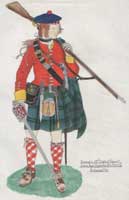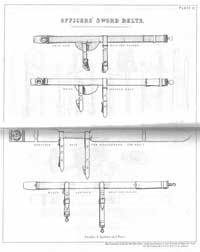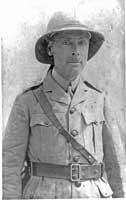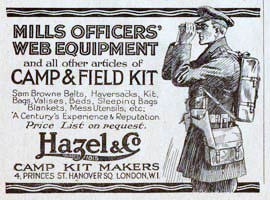OFFICERS’ ACCOUTREMENTS
 From earliest times, the weapon of an officer was the sword – a gentleman’s weapon! Originally, swords were universally carried on a Shoulder Belt, often termed a baldric, which was a very broad shoulder sling, which carried a bayonet frog style loop, into which the scabbard fitted, using a stud on the locket and carried either angled, or vertically. In the 18th Century, cavalry started to wear a narrow sword belt, with a pair of straps known as Carriages. The scabbard had upper and lower rings, the Carriage, short was attached to the top scabbard ring, the Carriage, long to the lower ring. The illustration at left, painted by R. J. Dennis, © 1966, shows a 42nd Highlander c. 1745, carrying his broadsword ina baldric. In 1865, Equipment of Infantry, Part V, was published, which illustrated regulation items of accoutrements for the first time. Plate II illustrated similar belts with carriages for infantry officers, Scottish officers continuing with the Belt, shoulder, for Highlanders.
From earliest times, the weapon of an officer was the sword – a gentleman’s weapon! Originally, swords were universally carried on a Shoulder Belt, often termed a baldric, which was a very broad shoulder sling, which carried a bayonet frog style loop, into which the scabbard fitted, using a stud on the locket and carried either angled, or vertically. In the 18th Century, cavalry started to wear a narrow sword belt, with a pair of straps known as Carriages. The scabbard had upper and lower rings, the Carriage, short was attached to the top scabbard ring, the Carriage, long to the lower ring. The illustration at left, painted by R. J. Dennis, © 1966, shows a 42nd Highlander c. 1745, carrying his broadsword ina baldric. In 1865, Equipment of Infantry, Part V, was published, which illustrated regulation items of accoutrements for the first time. Plate II illustrated similar belts with carriages for infantry officers, Scottish officers continuing with the Belt, shoulder, for Highlanders.
 Unless it was carried in the left hand, a sword scabbard on carriages would drag on the ground, hence the Shoe at its tip. To facilitate easier movement, a Sword hook was fixed adjacent to the front Carriage, to which the top scabbard ring could be attached. In time, a pistol was carried, which led to holsters, either on a shoulder sling, or worn directly on the waist belt. Most of an officer’s additional equipment was carried with unit transport, so he was therefore never as encumbered as the Rank and File, but water bottles, telescopes and haversacks were sometimes carried on separate shoulder slings.
Unless it was carried in the left hand, a sword scabbard on carriages would drag on the ground, hence the Shoe at its tip. To facilitate easier movement, a Sword hook was fixed adjacent to the front Carriage, to which the top scabbard ring could be attached. In time, a pistol was carried, which led to holsters, either on a shoulder sling, or worn directly on the waist belt. Most of an officer’s additional equipment was carried with unit transport, so he was therefore never as encumbered as the Rank and File, but water bottles, telescopes and haversacks were sometimes carried on separate shoulder slings.
 By the 1850s, “cap & ball” revolvers had made their appearance, so were more routinely carried and telescopes had been supplanted by field glasses. The requirements of campaigning still provided the officers with baggage animals, but the terrain of say the North-West Frontier, demanded that officers carried rather more “to hand” – weapons, ammunition, food and water, etc, at least for the period of being in action, away from the baggage train.
By the 1850s, “cap & ball” revolvers had made their appearance, so were more routinely carried and telescopes had been supplanted by field glasses. The requirements of campaigning still provided the officers with baggage animals, but the terrain of say the North-West Frontier, demanded that officers carried rather more “to hand” – weapons, ammunition, food and water, etc, at least for the period of being in action, away from the baggage train.
The arrangement of multiple slings and carriages did not make for easy movement and one enterprising young Indian Army officer set about designing something better. At the time, he was concerned only with improving the lot of officers only in his own regiment. His eponymous Belt was then taken up firstly by the Indian Army, then by the British Army. Ultimately, the Sam Browne Belt was adopted by almost every Army in the world, though by this time its purpose was more as the mark of an officer.
 When web equipment supplanted leather, officers continued with their regulation leather equipment. The Mills Equipment Company had designed a development of Patt. ’08 W.E. for officers, which received limited trials in 1910, but which was not taken into service. Their now distinctive leather accoutrements made officers an easy target, so early in the Great War, officers were directed to equip themselves with rankers’ web equipment. At the same time, military outfitters were offering “subdued” versions of Sam Browne’s equipment. These were either canvas, or canvas covered leather. It is not known whether this prompted M.E.Co. to gain their market-share, but they first adapted their existing rankers’ W.E. to Web Equipment. Patt. ’08, Officers, but then brought various design features from their lighter developments of infantry equipment. The result was Web Equipment for Officers, which was being worn by 1917. Post-war, Mills developed a slightly different pattern for R.A.F. officers and the Army’s version served alongside the Sam Browne Belt, which remained the regulation field equipment virtually up to the Second World War.
When web equipment supplanted leather, officers continued with their regulation leather equipment. The Mills Equipment Company had designed a development of Patt. ’08 W.E. for officers, which received limited trials in 1910, but which was not taken into service. Their now distinctive leather accoutrements made officers an easy target, so early in the Great War, officers were directed to equip themselves with rankers’ web equipment. At the same time, military outfitters were offering “subdued” versions of Sam Browne’s equipment. These were either canvas, or canvas covered leather. It is not known whether this prompted M.E.Co. to gain their market-share, but they first adapted their existing rankers’ W.E. to Web Equipment. Patt. ’08, Officers, but then brought various design features from their lighter developments of infantry equipment. The result was Web Equipment for Officers, which was being worn by 1917. Post-war, Mills developed a slightly different pattern for R.A.F. officers and the Army’s version served alongside the Sam Browne Belt, which remained the regulation field equipment virtually up to the Second World War.
With the introduction of Patt. ’37 W.E., in 1938, an officer-specific equipment could be created using elements of the Rank and File set, with added items special to officers. This established the standard and Patts. ’44, ’58 and ’90 were worn by both officers and men, the Sam Browne Belt then being reduced from a field equipment to a ceremonial equipment.
© R.J. Dennis February 2009